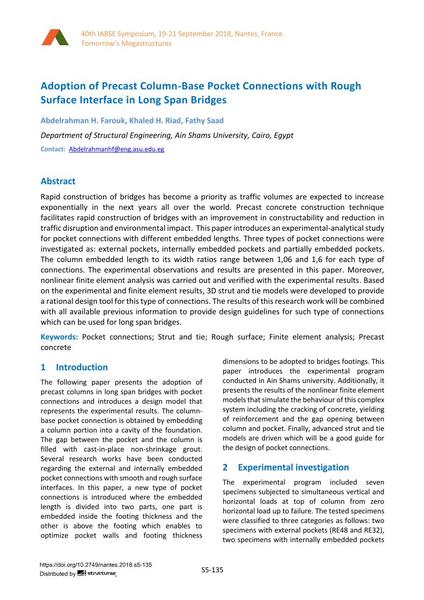Adoption of Precast Column-Base Pocket Connections with Rough Surface Interface in Long Span Bridges

|
|
|||||||||||
Détails bibliographiques
| Auteur(s): |
Abdelrahman H. Farouk
(Department of Structural Engineering, Ain Shams University, Cairo, Egypt)
Khaled H. Riad (Department of Structural Engineering, Ain Shams University, Cairo, Egypt) Fathy Saad (Department of Structural Engineering, Ain Shams University, Cairo, Egypt) |
||||
|---|---|---|---|---|---|
| Médium: | papier de conférence | ||||
| Langue(s): | anglais | ||||
| Conférence: | IABSE Symposium: Tomorrow’s Megastructures, Nantes, France, 19-21 September 2018 | ||||
| Publié dans: | IABSE Symposium Nantes 2018 | ||||
|
|||||
| Page(s): | S5-135 | ||||
| Nombre total de pages (du PDF): | 8 | ||||
| DOI: | 10.2749/nantes.2018.s5-135 | ||||
| Abstrait: |
Rapid construction of bridges has become a priority as traffic volumes are expected to increase exponentially in the next years all over the world. Precast concrete construction technique facilitates rapid construction of bridges with an improvement in constructability and reduction in traffic disruption and environmental impact. This paper introduces an experimental-analytical study for pocket connections with different embedded lengths. Three types of pocket connections were investigated as: external pockets, internally embedded pockets and partially embedded pockets. The column embedded length to its width ratios range between 1,06 and 1,6 for each type of connections. The experimental observations and results are presented in this paper. Moreover, nonlinear finite element analysis was carried out and verified with the experimental results. Based on the experimental and finite element results, 3D strut and tie models were developed to provide a rational design tool for this type of connections. The results of this research work will be combined with all available previous information to provide design guidelines for such type of connections which can be used for long span bridges. |
||||
